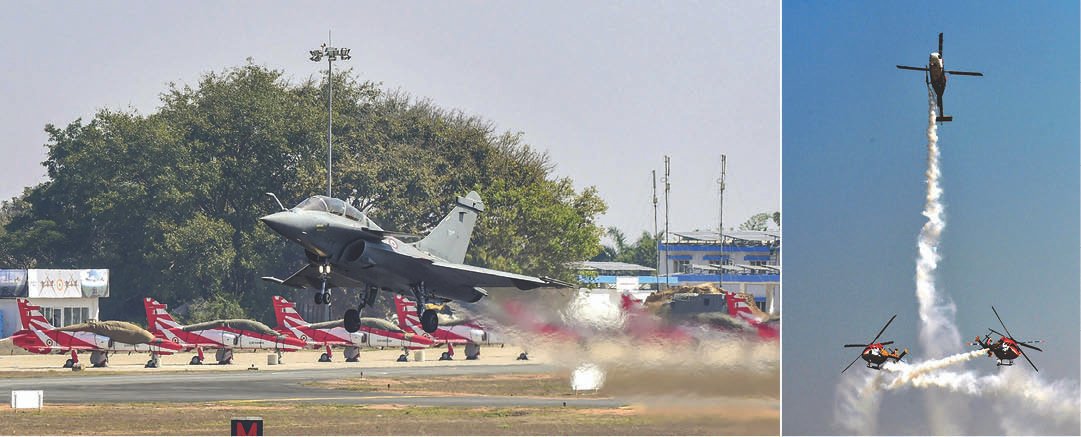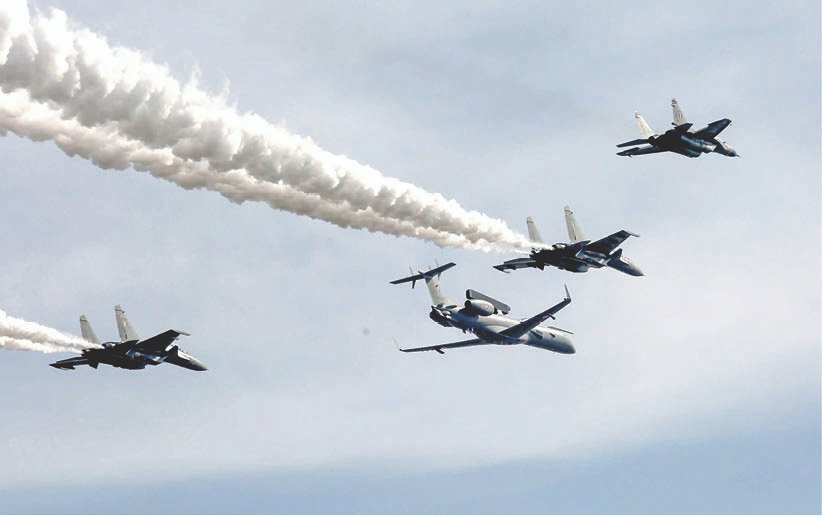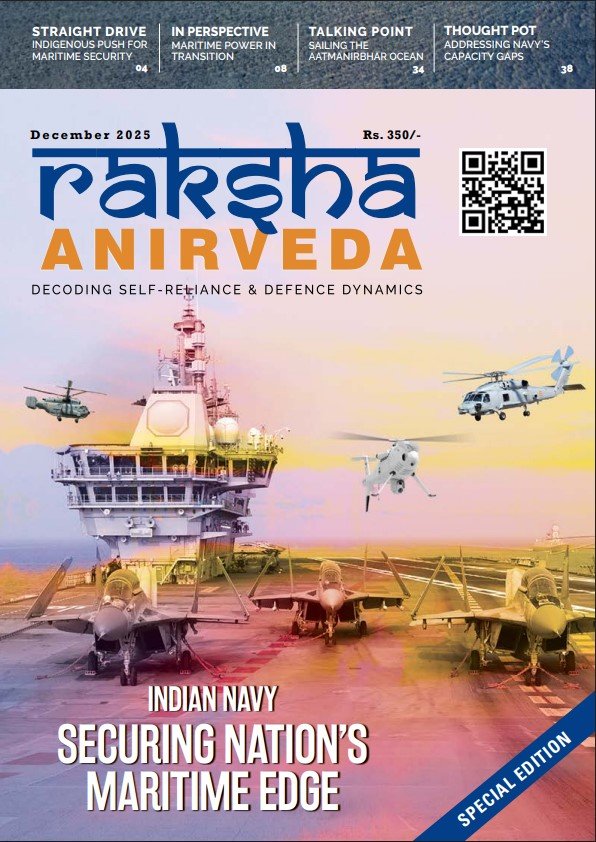The 15th edition of Asia’s biggest aero show aimed at forging new partnerships and explore avenues to fast-track indigenisation process, Aero India 2025 – will be held at the Air Force Station, Yelahanka in Bengaluru, Karnataka from February 10 to 14, 2025. With the broader theme The Runway to a Billion Opportunities, the event will provide a platform for forging partnerships between foreign and Indian firms and identifying newer avenues in the global value chain to accelerate the indigenisation process of Indian aero-defence companies.
The highlights of the Aero India will be the Defence Ministers’ Conclave, CEOs’ Round-Table, Manthan start-up event, breath-taking air shows and a display of indigenous manufacturing capabilities.
However, the past achievements of the event also compel one to act as the devil’s advocate and ask country’s defence planners and strategists that what holds them back to shape-up Aero India as a numero uno regional air show, or at least endeavour to be in the top five global air shows.
Concurrently, they should also ponder over how to leverage the huge pool of India’s skilled and technologically savvy workforce to become a part of the global aircraft manufacturing ecosystem.
Evolving as a future partner of the global aircraft manufacturing system will not only boost the country’s aero-defence manufacturing industry, but also provide access to the Indian Air Force (IAF) to the best available air machines, in addition to helping it to fulfil its numerical shortfall. Further, becoming a part of the global aircraft manufacturing system will generate ample job opportunities for the large pool of skilled manpower in the country.
On how to become a part of the global aircraft manufacturing ecosystem, India can take lessons from three global cases, where different nations have pooled together their technical prowess and economic resources to develop new global aircrafts, by shortening the plan to delivery time gap and pitching-in with their area of expertise.
Global Combat Air Programme (GCAP)
The first example is that of the Global Combat Air Programme (GCAP), which is a multinational initiative, led by the United Kingdom with Japan and Italy to jointly develop a 6th generation stealth fighter. The programme aims to replace the Eurofighter Typhoon in service with the Royal Air Force (RAF) and Italian Air Force, and the Mitsubishi F-2 in service with the Japan Air Self-Defence Force.
The strategically important multilateral partnership of GCAP, brings together the governments of the UK, Italy and Japan, and their respective industries, led by BAE Systems (UK), Leonardo (Italy) and Mitsubishi Heavy Industries (Japan) to collaborate on shared military and industrial objectives in the delivery of a next generation combat air capability.
The past achievements of Aero India, compel one to act as the devil’s advocate and ask country’s defence planners and strategists that what holds them back to shape-up Aero India as the leading regional air show, or at least endeavour to be in the top five global air shows
The combat aircraft, called Tempest in the UK earlier, is set to be in service by 2035 and will be one of the world’s most advanced, interoperable, and adaptable fighter jets in service.
This unique partnership not only drives innovation and technological advancement but also promotes significant economic growth in each nation, securing the future of their respective combat air industries for decades.
Reportedly, the Swedes, the Germans and the Saudis may also join this multilateral programme, soon.

Future Combat Air System (FCAS)
Secondly, Germany, France, and Spain are mutually developing the European weapon system of the future, the Future Combat Air System (FCAS).
The FCAS project itself has now reached the demonstration phase. Germany and France began planning a combat aircraft in 2017. In 2019, Spain joined the project and the defence ministries of three nations signed a framework agreement on the mutual development of the FCAS. In June 2023, Belgium became an Observer to the FCAS programme, and is set to join the programme by June 2025
Eurodrone programme
Third, comes the example of Eurodrone, which is a 4-nation development programme comprising Germany, France, Italy, and Spain, led by the Organisation for Joint Armament Cooperation (OCCAR). Airbus Defence and Space (GER) is the industrial prime contractor for the project, together with Leonardo (ITA), Dassault Aviation (FRA) and Airbus Defence and Space (SPA) acting as major subcontractors. Germany is the lead nation for the programme.
Moreover, OCCAR has accepted India’s application as an Observer for the Eurodrone programme. This will provide New Delhi with an opportunity to closely monitor the four-nation drone project. It would keep India better informed for future procurement of the platform or allow it to incorporate the lessons into its own domestic projects. As an Observer, India could gain access to briefings on the drone’s technical specifications and operational capabilities.
India’s Tech Prowess and Growing Confidence
Indian Navy’s MiG-29K is set to make its debut at Aero India. The backbone of the Indian Naval Air Arm, will be on static display at Aero India 2025. The aircraft has been upgraded with new mission computer developed by HAL and cutting-edge armament with ASTRA missiles and enhanced avionics suite in the recent years. It was inducted in the Indian Navy in 2010 and has proved to be the backbone of Indian Navy’s air arm, till date.
Also, India’s advanced indigenous Intermediate Jet Trainer – IJT (HJT 36) also known as Sitara is to be exhibited at Aero India and will also be a part of the aerial display at the aero show. This programme is a testament to HAL’s commitment to developing indigenous defence technologies and overcome technical challenges. Its anticipated full-scale production by 2028 will be a significant milestone for India’s Aatmanirbharta in aero-defence manufacturing and will provide the IAF with a much-needed modern trainer aircraft.
The above two examples demonstrate the tenacity of the Indian engineers and technicians to maintain aircrafts which have ceased production in their host country, yet they continue to operate by the Indian defence forces. IJT is an example of perseverance by Indian engineers developing their expertise in developing the IJT, albeit with delays. Such technical prowess and experience can be used in any future aircraft manufacturing process also.

The Way Ahead
The above examples show clearly that multilateral cooperation is the way ahead for the future, when nations aspire to gain a tactical and technological upper hand over their adversaries but either a lack of technical prowess or financial strength prohibits them from doing so alone.
India can learn valuable lessons from the Eurodrone programme and our defence honchos can leverage this to get India inducted into any foreseeable multilateral aircraft manufacturing programme or also try to get involved in the current programmes like the GCAP and FCAS. This may not only help them to fulfil the IAF’s requirements but also generate jobs for the huge skilled manpower pool available in India.
As regards to what India would bring to the table, a point raised by Japan for including Saudi Arabia in the GCAP programme, then India could counter it by offering the vast technologically sound and skilled workforce for the programme, besides the lower cost of manufacturing through its already booming aero manufacturing sector.
India can also initiate a novel joint manufacturing project for its AMCA programme on its own with like-minded countries like Taiwan, Saudi Arabia and UAE to achieve its Aatmanirbharta targets and develop a machine which could be touted as an example of indigenous and self-reliant pursuit
Additionally, India can also initiate a novel joint manufacturing project for its AMCA programme with like-minded countries like Taiwan – sensitive considering geostrategic implications but a worthwhile option, besides the UAE and Saudi Arabia – both of which want to be part of an international platform to develop viable options particularly in the aerial domain, to achieve its Aatmanirbharta targets and develop a machine which could be touted as an example of indigenous and self-reliant pursuit.
Adopting such an innovative approach will surely help the defence ministry to achieve its armaments export targets by 2029 and also helping in achieve the complete Aatmanirbhar and Viksit Bharat initiatives by 2047.
Being ambitious is not the only goal, to achieve that goal one is also required to think out of the box and apply some innovative measures to achieve success and fly proudly.
-The writer is a New Delhi-based senior commentator on international and strategic affairs, environmental issues, an interfaith practitioner, and a media consultant. The views expressed are personal and do not necessarily carry the views of Raksha Anirveda






